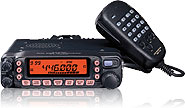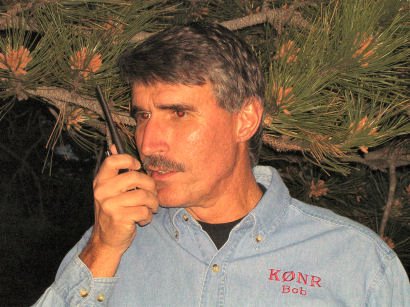
The amateur radio community has been buzzing about
Motorola's purchase of Yaesu. Actually, the deal is structured as a joint venture with Mot owning 80% of Vertex Standard (Yaesu is the marketing name for Vertex ham products.) The speculation is running wild on
eham.net and other forums about what this means. As usual, these opinions are mostly bull hockey speculation... worth about what you paid for it.
This caused me to dig into the numbers behind this deal. How big is Vertex and how much of that is amateur radio? The total purchase price for 80% of the shares will be approximately ¥12.3 billion (or about US $108 million). From a
PRNewswire report, Vertex sales for the fiscal year ending March 2007 were approximately ¥21.98 billion or $192.8 million. On the Vertex web site, I found a
breakout of their revenues by product type: 27% ham radio, 70% land mobile and 3% data terminal. This means their ham radio sales are about $52M annually.
A look at
Kenwood's 2007 Annual Report reveals that their Communications Equipment Business is about 36% of their total business, or $514M. The Communications Equipment Business includes Land Mobile Radio, Amateur Radio and some consumer wireless devices. I did not find the amateur radio number broken out separately. It is interesting that Kenwood's annual report emphasizes their Land Mobile business and claims they are #2 in market share in that business. (I assume Mot is #1.)
ICOM's 2007 Annual Report shows their annual sales at $263.5M, almost all in the category of "Radio". Just like Kenwood and Vertex, ICOM sells radio equipment to both the land mobile and the amateur radio markets.
I can't conclude from the data the specific amateur radio market share for these companies. However, if we look at the combined amateur+land mobile markets, these companies look like this:
- Vertex: $192.8M
- Kenwood: $514M
- ICOM: $263.5M
This is probably not a true "apples to apples" comparision, but it gives a rough feel for the relative size of these businesses. If we assume that Vertex is representative of these companies, then we see that the land mobile business is over twice the size of the amateur business. Not a surprise.
What does this mean for Motorola and Vertex? Hard to say, really. The main conclusion for me is that the land mobile market is the dominate business, with amateur radio playing the role of "little sister." The amateur radio portion of Vertex probably lives or dies based on it profitability and how well it can leverage the land mobile R&D investment.
73, Bob K0NR
 The amateur radio community has been buzzing about Motorola's purchase of Yaesu. Actually, the deal is structured as a joint venture with Mot owning 80% of Vertex Standard (Yaesu is the marketing name for Vertex ham products.) The speculation is running wild on eham.net and other forums about what this means. As usual, these opinions are mostly bull hockey speculation... worth about what you paid for it.
The amateur radio community has been buzzing about Motorola's purchase of Yaesu. Actually, the deal is structured as a joint venture with Mot owning 80% of Vertex Standard (Yaesu is the marketing name for Vertex ham products.) The speculation is running wild on eham.net and other forums about what this means. As usual, these opinions are mostly bull hockey speculation... worth about what you paid for it.


4 Comments:
I had no idea that the ham market was this big! Is there room for niche products such as quality remote control hardware/software?
Ken, W6XB
With Motorola being a force behind the BPL (broadband by powerline) HomePlug Alliance, the Yaesu amateur radio division of Vertex appears to sit very uncomfortably within the Motorola merger.
The HomePlug Alliance would like to see the back of amateur radio altogether, so that their BPL adapters can continue to abuse the H.F. radio spectrum with impunity.
Perhaps the Yaesu amateur radio division will not last too much longer?
Mike
M0MTJ
Mike,
According to the testing that the ARRL has done, the HomePlug standards are "ham friendly" because they notch their radiated emissions in the ham bands. See http://p1k.arrl.org/~ehare/bpl/Descriptions/Current_Technologies.html
Also, Motorola was working with the ARRL in the US to address BPL interference concerns. There was even a Motorola BPL system deployed at ARRL headquarters as a test. See http://www.arrl.org/news/stories/2005/08/29/1/
I believe that Mot has abandoned its pursuit of BPL anyway.
http://www.arrl.org/news/stories/2007/04/25/102/?nc=1
73, Bob K0NR
Thanks for the additional information Bob, it is very interesting.
Maybe some good will come of the Motorola / Yaesu partnership. Let's hope so.
BPL over power company infrastructure does not seem to have been adopted in the UK yet. However HomePlug adapters used by individuals in their homes is a real and growing threat here.
It's true that the ham bands should be "notched" out, and some adapters conform to this standard. It does seem, from what I have gathered, that there is some pressure to abandon this "notching" so that the adapters can use the whole HF band.
I don't know what will happen in this respect in the future.
Having said that, even if the home adapters continue to be notched, I cannot understand how the manufacturers and users of these devices are allowed, by the national regulators, to abuse the rest of the HF radio spectrum with wide band interference.
I imagine that there are many amateurs waiting with some considerable trepidation should one or more of these devices be installed nearby!
Thanks.
73
Mike
M0MTJ
Post a Comment
Links to this post:
Create a Link
<< Home